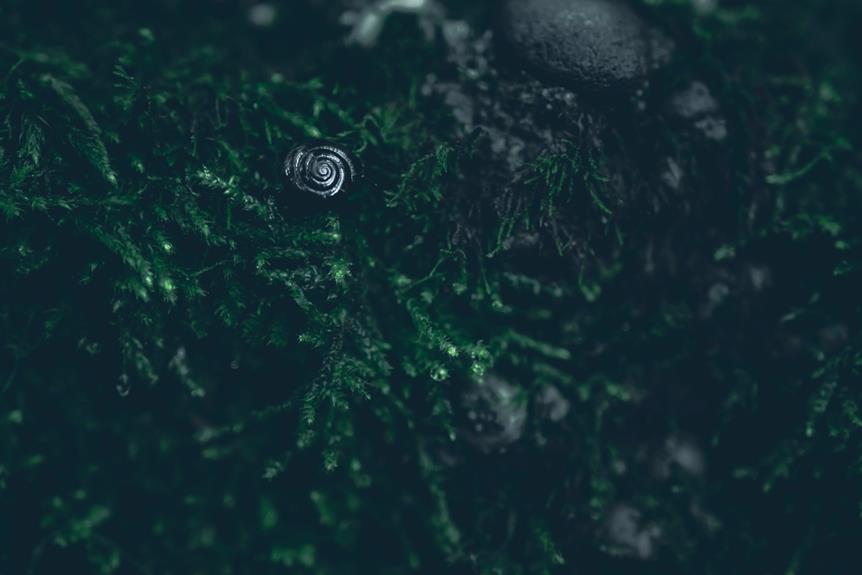Selecting appropriate tank mates for red-eared slider turtles is a meticulous process that demands attention to detail. The compatibility and coexistence of different species within a shared aquatic habitat can significantly impact the overall welfare of the inhabitants.
From peaceful mystery snails to vibrant guppies, the options seem endless, but the key lies in understanding the unique requirements and behaviors of each prospective companion.
By considering factors such as size, temperament, and dietary needs, the quest for the ideal tank mates becomes a delicate balance of science and art.
Key Takeaways
- Choose tank mates like mystery snails and guppies for red-eared sliders
- Consider cichlids and rosy red minnows as suitable companions
- Avoid pairing red-eared sliders with turtles or frogs
- Ensure tank mates are colorful, peaceful, and compatible with the sliders' needs
Mystery Snails
Mystery snails, known for their vibrant colors and quiet manners, make suitable tank mates for red-eared slider turtles due to their playful yet careful nature around others. When considering snail care in a tank shared with turtles, it is essential to use fully mature snails to minimize the risk of juvenile snails being eaten by mature turtles.
Mystery snails are ideal for community tanks, adding a pop of color and interest. Understanding turtle behavior is crucial when introducing tank mates. These snails are peaceful creatures that can coexist harmoniously with red-eared sliders. By providing a well-maintained tank environment and suitable tank conditions for both snails and turtles, a balanced ecosystem can be achieved.
Pictus Catfish
Known for their distinctive appearance and behavior, Pictus catfish are a popular choice as tank mates for red-eared slider turtles. These catfish are small enough to be devoured by turtles but do not share territory with them, making them a suitable companion in the tank. Pictus catfish have radiant manners and lively swimming patterns, adding vibrancy to the aquatic environment. They spend time hunting and collecting food at the bottom of the tank, contributing to its overall ecosystem. When considering Pictus catfish as tank mates for red-eared sliders, it is important to take into account their feeding habits and the tank decorations to ensure a harmonious cohabitation.
| Feeding Habits | Tank Decorations |
|---|---|
| Bottom feeders | Caves and hiding spots |
| Omnivorous diet | Plants and driftwood |
| Require varied diet | Smooth surfaces |
| Thrive on live food | Substrate for foraging |
Guppies
Guppies are a commonly recommended tank mate for red-eared slider turtles due to their ease of care and fast reproductive rate. These small, colorful fish are known for their breeding habits, often giving birth to live fry rather than laying eggs. Guppies are omnivores with a preference for small insects, algae, and plant matter, making them compatible with the dietary needs of red-eared sliders.
Their quick reproductive cycle can provide a sustainable source of live food for turtles. However, it is essential to monitor the guppy population as they can multiply rapidly and overpopulate the tank. By controlling their numbers and providing a balanced diet, guppies can be excellent companions for red-eared slider turtles.
Cichlids
Cichlids, known for their bright skins and aggressive manners, are a popular choice as tank mates for red-eared slider turtles due to their ease of care and compatibility with shared tank environments. When considering cichlids as companions for your turtles, it's important to understand their breeding habits and the water parameters they require:
- Breeding Habits: Cichlids are known for their intricate breeding behaviors, which can add an interesting dynamic to your tank environment. Understanding their breeding habits can help you create a suitable setup for both the cichlids and your red-eared slider turtles.
- Water Parameters: Cichlids have specific water parameter requirements, including pH levels, temperature, and water hardness. Ensuring that these parameters are within the optimal range will help maintain the health and well-being of both the cichlids and your turtles.
Rosy Red Minnows
When considering suitable tank mates for red-eared slider turtles, Rosy Red Minnows are a cost-effective and readily available option known for their compatibility with these turtles and peaceful demeanor in shared tank environments.
Rosy Red Minnows, also known as Fathead Minnows, are a hardy species that can adapt to various water conditions, making them suitable companions for red-eared sliders. In terms of breeding habits, these minnows are prolific breeders, so it's essential to provide adequate hiding spots for the fry to prevent them from being eaten.
Additionally, maintaining stable water chemistry with proper filtration and regular water changes is crucial for the health and well-being of both the minnows and the turtles when cohabitating.
Compatibility Factors to Consider
Consideration of various compatibility factors is paramount when selecting tank mates for red-eared slider turtles to ensure a harmonious cohabitation environment.
Factors to Consider:
- Size Disparity: Choose tank mates that are similar in size to prevent aggression or potential harm to smaller companions.
- Dietary Needs: Ensure that the tank mates have compatible dietary requirements to avoid competition for food and potential malnutrition.
- Behavioral Compatibility: Select species that exhibit peaceful behaviors and are not prone to stress-induced behaviors, promoting a tranquil environment for all inhabitants.
Tank Size and Habitat Requirements
In order to provide optimal living conditions for red-eared slider turtles and their tank mates, it is essential to carefully consider the tank size and habitat requirements. Red-eared sliders require a spacious tank due to their active nature, with a general rule of providing 10 gallons of water per inch of turtle shell.
Habitat enrichment is crucial, including basking areas, UVB lighting, and proper filtration systems to maintain water parameters like temperature and cleanliness. Understanding the social dynamics and feeding habits of both red-eared sliders and their tank mates is vital to ensure compatibility.
Diet Considerations for Tank Mates
To ensure the health and well-being of both red-eared slider turtles and their tank mates, a critical aspect to consider is the dietary compatibility among the inhabitants. Understanding the feeding habits and nutritional needs of all species in the tank is crucial for maintaining a harmonious environment. Here are three key points to consider:
- Feeding Habits: Different species have varying feeding behaviors, ranging from herbivores to carnivores. It is essential to select tank mates whose diet aligns with the feeding habits of red-eared slider turtles to prevent competition or malnutrition.
- Nutritional Needs: Ensuring that all tank mates receive adequate nutrition is vital for their overall health. Each species may have specific dietary requirements that need to be met to thrive in a shared tank environment.
- Balanced Diet: Offering a balanced diet to all tank inhabitants can promote optimal health and reduce the risk of nutrient deficiencies. Variety in food choices can cater to the diverse nutritional needs of different species, fostering a well-rounded ecosystem within the tank.
Behavioral Observations and Interactions
Engaging in careful behavioral observations and monitoring interactions among red-eared slider turtles and their tank mates is essential for understanding their social dynamics and ensuring a harmonious cohabitation environment.
Observation techniques such as recording daily interactions, noting feeding behaviors, and tracking any signs of aggression or stress are crucial in maintaining a balanced tank ecosystem. By closely monitoring social dynamics, such as hierarchy establishment and territorial behaviors, one can intervene timely to prevent conflicts or potential harm.
Understanding the social dynamics within the tank allows for the creation of an environment where all species can coexist peacefully. This proactive approach fosters a healthier and more enjoyable habitat for red-eared slider turtles and their tank mates.
Monitoring and Adjusting Tank Dynamics
Efficient management of tank dynamics is crucial for maintaining a harmonious cohabitation environment among red-eared slider turtles and their tank mates. To ensure a balanced ecosystem, consider the following:
- Tank Enrichment: Providing a variety of hiding spots, basking areas, and aquatic plants can help reduce stress and territorial behaviors among tank inhabitants. Enrichment activities like puzzle feeders or floating platforms can also stimulate natural behaviors and prevent boredom.
- Behavioral Monitoring: Regularly observe the interactions and behaviors of all tank mates to detect any signs of aggression, stress, or illness. Understanding the dynamics between species will enable you to make informed adjustments to promote a peaceful coexistence.
- Water Quality Maintenance: Monitoring and maintaining appropriate water parameters, such as temperature and pH levels, are essential for the overall health and well-being of all tank inhabitants. Regular water changes and filtration system checks are vital to prevent any potential conflicts due to poor water conditions.
Frequently Asked Questions
Can Red-Eared Slider Turtles Live With Other Turtles of Different Species?
Compatibility issues arise when considering housing red-eared slider turtles with other turtle species due to potential aggression, differences in size, and habitat preferences. Behavior observations are crucial to ensure a harmonious cohabitation and prevent conflicts.
Are There Any Specific Plants That Can Be Kept in a Tank With Red-Eared Slider Turtles?
Aquatic plants and tank decor suitable for red-eared slider turtles include Anubias, Java fern, and hornwort. Ensure they are non-toxic and sturdy. Dietary supplements like calcium are vital, along with UV lighting for basking. Regular monitoring is essential for optimal health.
What Types of Invertebrates Can Coexist Peacefully With Red-Eared Slider Turtles?
In considering invertebrate interactions within tank setups for red-eared slider turtles, it is essential to evaluate feeding habits and compatibility. Understanding the dynamics of coexistence and ensuring suitable conditions will contribute to a harmonious aquatic environment.
How Can Water Quality Be Maintained When Housing Red-Eared Slider Turtles With Tank Mates?
To maintain water quality in a tank housing red-eared slider turtles with mates, ensure appropriate tank size for all inhabitants. Use efficient filtration systems, monitor water temperature, and select compatible tank mates. Regular water changes and monitoring parameters like pH and ammonia levels are crucial for a healthy aquatic environment.
Are There Any Specific Breeding Considerations to Keep in Mind When Keeping Red-Eared Slider Turtles With Tank Mates?
Breeding challenges with tank mates for red-eared slider turtles involve ensuring compatibility, understanding reproductive behavior, and managing tank dynamics. Consider species' mating habits, space requirements, and potential conflicts to maintain a harmonious environment.
Conclusion
In conclusion, selecting suitable tank mates for red-eared slider turtles requires careful consideration of various factors such as size, temperament, and dietary requirements. By understanding the specific needs and behaviors of potential companions, aquarists can create a harmonious and thriving aquatic ecosystem.
Monitoring interactions and adjusting tank dynamics as needed are essential to ensuring the well-being and safety of all inhabitants. As the saying goes, 'A diverse community thrives when each member's unique strengths are recognized and valued.'





